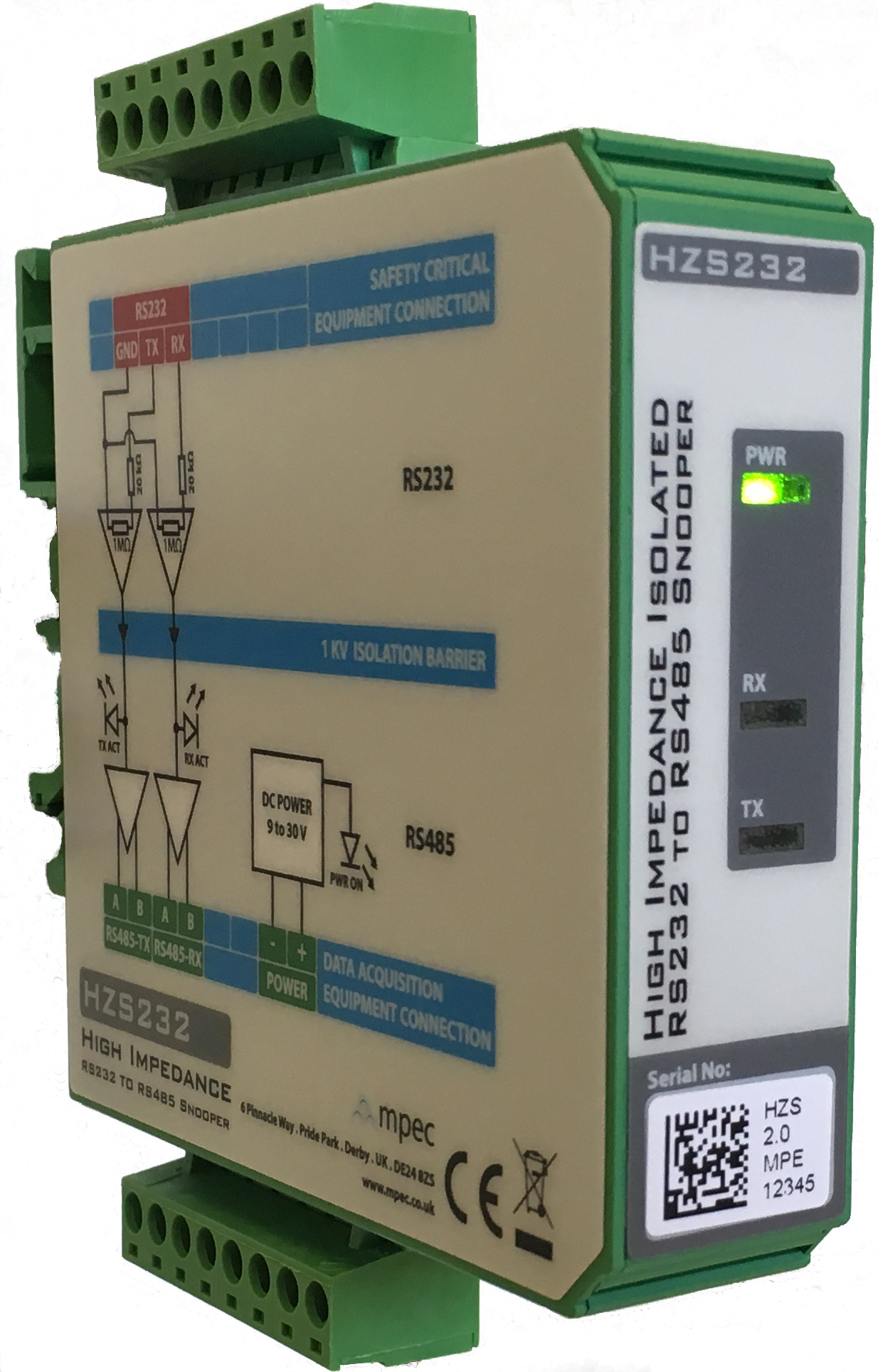/
HZS232 User Guide
HZS232 User Guide
Use Case:
The "HZS232 RS232 to RS485 snooper" facilitates the monitoring of a full-duplex RS232 link in a minimally intrusive and low risk manner.
It is designed primarily for the monitoring of data links in safety critical, high reliability systems, such as Railway Signalling TDM control systems.
Key Features:
- Separate high impedance, fault tolerant input buffers monitor RS232 transmit and receive lines.
- Buffered RS232 to RS485 protocol conversion prevents downstream monitoring systems from injecting data into the RS232 line.
- RS485 output allows long-distance wiring runs, and provides enhanced electromagnetic immunity between HZS232 and monitoring equipment.
- 1 kV galvanic isolation barrier guards against ground loop problems, unintentional earth paths, or other unwelcome circuit connection.
System Diagram:
Indications
The HZS232 incorporates 3 x Indication LED's to aid the identification of correct operation.
| Indication | Steady On | Steady Off | Blinking |
|---|---|---|---|
| Power | Correct Function | Fault | Fault |
| TX | Fault | No data traffic | RS232 Data Observed on the Transmit line |
| RX | Fault | No data traffic | RS232 Data Observed on the Receive line |
Wire Termination
- Wire termination is via 5 mm-pitch 8-way connectors.
- The connector assignment has been arranged such that the monitored system shall not be compromised if the plug is inserted into the incorrect socket of the HZS232.
- The correct terminations are clearly marked on the product.
- Reading from left-to-right, the correct pin assignment is further detailed below:
| Safety Critical Equipment Connection | Notes | |
|---|---|---|
| 1 | No Connection | |
| 2 | No Connection | |
| 3 | No Connection | |
| 4 | No Connection | |
| 5 | RS232 RX Line |
|
| 6 | RS232 TX Line | |
| 7 | RS232 GND Line | |
| 8 | No Connection |
| Data Acquisition Equipment Connection | Notes | |
|---|---|---|
| 1 | RS485 "TX" data-stream A Connection |
|
| 2 | RS485 "TX" data-stream B Connection | |
| 3 | RS485 "RX" data-stream A Connection |
|
| 4 | RS485 "RX" data-stream B Connection | |
| 5 | No Connection | |
| 6 | No Connection | |
| 7 | -Power |
|
| 8 | + Power |
A Note about Cable Terminations
Correct selection of cable type and termination method to safety critical systems is beyond the scope of this user guide
- Please ensure the cabling used to connect to safety critical systems is of the correct type and carries the correct approvals.
- Please ensure that the appropriate termination method is employed.
- Common "Punch-Down-Blocks" require the use of solid-conductor cable and the use of appropriate termination tools.
- Common D9 connectors may use multi-stranded cable, but require the pin assignment of the plug to be carefully checked.
Specification
| Electrical | |
|---|---|
| Serial Input | 1 x RS232 Full-Duplex 3-Wire Input |
| Serial Output | 2 x RS485 Half-Duplex 2-Wire Output |
| Baud Rate | 57,600 bps max. |
| Input Impedance | > 1 MΩ on both RS232 TX and RX Lines |
| Power Supply | 9 V to 30 V DC |
| Power Consumption | 0.5 W at 12 V DC 0.6 W at 24 V DC |
| Isolation | > 4 MΩ at 1,000 V DC |
| Indications | Power, TX Active, RX Active |
| Mechanical | |
|---|---|
| Length | 102 mm |
| Width | 22.5 mm |
| Height | 82 mm |
| Weight | 80 g |
| Mounting | DIN Rail |
| Environmental Ratings | |
|---|---|
| IP Rating | 4X |
| IK Rating | 06 |
| Temperature Range | -25 to +85 °C |
| Flammability | UL94-V0 |
, multiple selections available,
Related content
SA380TX User Guide
SA380TX User Guide
Read with this
SA380TX-L User Guide
SA380TX-L User Guide
Read with this
SA380-IT User Guide
SA380-IT User Guide
Read with this
SA380TX Hardware
SA380TX Hardware
Read with this
